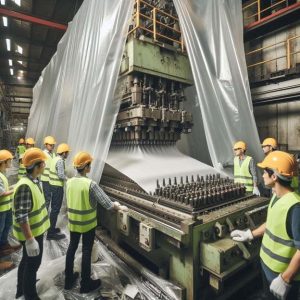 In recent years, sustainability has become a central issue in industrial practices. Governments, businesses, and consumers are becoming more aware of the environmental impact of various materials used across sectors. One of the key materials being discussed is the tarpaulin. Traditional PVC tarps, widely used in industrial settings, have faced criticism due to their environmental footprint. This has led to a surge in conversations about sustainable alternatives such as eco-friendly tarpaulins (dekzeil).
In recent years, sustainability has become a central issue in industrial practices. Governments, businesses, and consumers are becoming more aware of the environmental impact of various materials used across sectors. One of the key materials being discussed is the tarpaulin. Traditional PVC tarps, widely used in industrial settings, have faced criticism due to their environmental footprint. This has led to a surge in conversations about sustainable alternatives such as eco-friendly tarpaulins (dekzeil).
Why Eco-Friendly Tarpaulins Are Gaining Attention
The production and disposal of traditional tarpaulins, particularly those made from PVC, contribute significantly to pollution. PVC is non-biodegradable and its manufacturing process releases harmful chemicals into the environment. This has sparked political debates globally, with governments and environmental bodies advocating for a shift towards eco-friendly alternatives. Industrial tarps made from sustainable materials, such as polyethylene and biodegradable compounds, are now in focus. These eco-friendly tarpaulins offer the same durability and strength as their PVC counterparts but have the added benefit of a reduced environmental impact.
The Political Push for Sustainable Industry Practices
Politicians and environmental groups are essential in pushing industries toward adopting sustainable materials. Many countries are beginning to enforce regulations that restrict the use of harmful materials like PVC. The pressure from lawmakers is driving industries to explore alternatives such as eco-friendly tarpaulins. Furthermore, some governments are offering incentives to companies that make the switch to greener options, encouraging the adoption of sustainable cover solutions in industries like construction, transportation, and agriculture.
This movement is part of a broader push towards a circular economy, where materials can be reused, recycled, and repurposed with minimal environmental impact. Eco-friendly tarps fit well into this model, as many of them can be recycled or are made from biodegradable materials.
Industrial Tarps and Their Environmental Impact
Industrial tarps are widely used in sectors such as logistics, agriculture, and manufacturing. These tarps protect goods, machinery, and materials from the elements. However, the environmental cost of using traditional tarpaulins has raised concerns. PVC tarps, which dominate the market, take hundreds of years to degrade and release harmful chemicals during decomposition.
This realization has shifted the focus toward sustainable cover options, such as eco-friendly tarps. These alternatives are made from recyclable materials and can be repurposed, reducing the need for constant production and disposal. Additionally, they are often lighter, requiring less energy to transport, further lowering their carbon footprint.
Advantages of Eco-Friendly Tarpaulins in Industrial Settings
Switching to eco-friendly tarps offers numerous benefits for industries:
- Reduced environmental impact: Eco-friendly tarps help reduce pollution and greenhouse gas emissions by using sustainable materials.
- Durability: Just like traditional tarps, eco-friendly alternatives are durable, waterproof, and resistant to wear and tear.
- Cost-effective: While initial costs may be slightly higher, the long-term savings from using reusable and recyclable materials make eco-friendly tarps a wise investment.
- Regulatory compliance: Many governments are starting to ban harmful materials, and switching to eco-friendly options ensures compliance with environmental regulations.
- Enhanced brand image: Companies that adopt sustainable practices often receive positive attention from consumers, improving their public image and customer loyalty.
The Role of Consumers and Corporations
Consumers are also driving the demand for eco-friendly alternatives. With growing awareness of environmental issues, people are becoming more conscious of the products they buy and the companies they support. Businesses that switch to sustainable materials like eco-friendly tarpaulins can not only meet regulatory requirements but also align themselves with the values of environmentally-conscious consumers.
Corporations that have embraced sustainability as part of their business strategy have seen positive impacts on both their public relations and their bottom line. By investing in eco-friendly materials, companies not only reduce their environmental impact but also attract a new wave of customers who prioritize sustainability.
Challenges in Implementing Sustainable Materials in Industry
Despite the clear benefits, there are still some challenges to adopting eco-friendly tarps and other sustainable materials on a large scale. For instance, the cost of developing and manufacturing sustainable alternatives can be higher, especially in the early stages. Additionally, some industries may resist change due to existing supply chains and the reliability of current materials. However, with governments introducing stricter regulations and offering incentives, these barriers are slowly being overcome.
The debate around sustainable materials isn’t just limited to tarps; it extends to various other industrial products and processes. As more industries recognize the need for eco-friendly solutions, the demand for innovations in sustainable materials will continue to grow.
READ ALSO: Governance of Natural Resources in the Manufacturing and Production of Electronics and Appliances
Conclusion: A Sustainable Future for Industry
The shift toward sustainable materials is no longer a niche topic. It has become a critical issue at the forefront of political discussions and industrial reforms. Eco-friendly tarpaulins represent just one example of how industries can adapt to meet environmental demands without compromising on functionality or quality. As regulations tighten and consumer demand increases, the transition to sustainable cover options in industries will likely accelerate. By adopting eco-friendly tarps, companies can reduce their environmental impact and contribute to a greener, more sustainable future.




